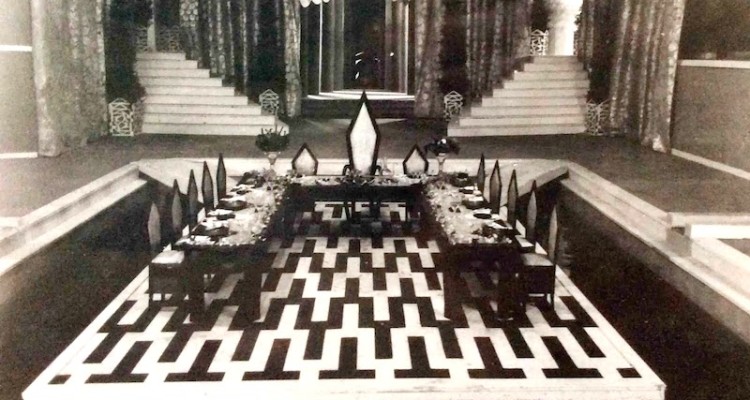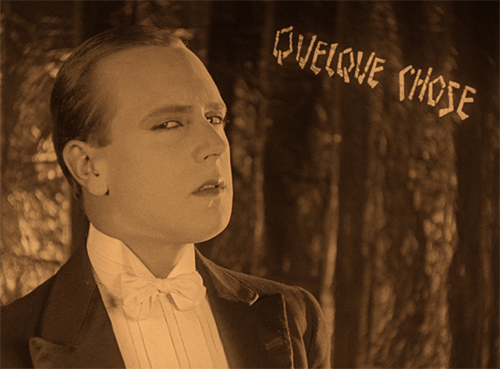L'INHUMAINE

Release Date: 1924
by David Melville, SensesofCinema.com
‘On leaving the theatre one has the impression of having witnessed the birth of a new art.’- Adolf Loos
What to say about a film that, ninety years on from its release, is still so far ahead of most of what passes for cinema today? L’Inhumaine was made by Marcel L’Herbier in 1924; no other silent film, perhaps, could match its sheer stylistic and imaginative daring. Since the coming of sound, only a few directors have even attempted what L’Herbier pulled off with such flair: Alain Resnais with Last Year in Marienbad (L’Année Dernière á Marienbad, 1961), or maybe Marguerite Duras with India Song (1975), perhaps? Films whose hypnotic, languorous surface are not just a matter of style but also the very substance of the works themselves.
Of course, L’Inhumaine must be one of the most absurd Great Movies ever made. The ludicrous plot by L’Herbier and the best-selling author Pierre Mac Orlan concerns a femme fatale and her four suitors. A crass American showman wants her to become the world’s greatest star. A crazed Russian mystic wants her to inspire a new revolution. A sinister Hindu maharajah wants her to take the throne as his queen. An idealistic young scientist (played by L’Herbier’s close friend and protégé Jaque-Catelain) loves her purely and poetically, for herself. None of these relationships is at all convincing, least of all that of the lady and the scientist (which wins out).

Georgette Leblanc stars in L’Inhumaine and also financed it. She was not a film actress but an opera diva, famous for creating the lead role in Claude Debussy’s tuneless but atmospheric opera Pelléas et Mélisande in 1902. She was, for two decades, the wife and muse of the Belgian Symbolist poet Maurice Maeterlinck, on whose play that opera was based. She had no inkling of how to act for the camera and her performance is predictably stilted and ‘operatic’. Moreover, she was 55 years old, almost thirty years older than her delicate and androgynous leading man. L’Inhumaine seems designed to give the term ‘vanity project’ a bad name.
Granted that L’Inhumaine ought not – by any sane standards – to be a great film, our wonder lies in discovering how and why it is one. It is essential that cinema, for L’Herbier and his team, was not about narrative. Writing of L’Herbier and his more famous and bombastic contemporary Abel Gance, Dudley Andrew points out how “their real concern all along was with style, visual tempo, subjective states, delicate textures and private sensibility.” 2 The aim was less to tell a story than to evoke a subjective and profoundly interior world through objective visual means.
Film historians have labelled this style ‘Impressionist’ but the term is lazy and misleading. L’Herbier’s films in no way resemble the work of the Impressionist painters in the way those of a Realist filmmaker like Jean Renoir so often do. The prevailing mood as L’Inhumaine opens is closer to Surrealism or even Abstraction. The diva’s coterie of admirers gathers for a banquet in her mansion (a set designed by the future directors Claude Autant-Lara and Alberto Cavalcanti). The dining table stands on a pontoon floating in a pool, with a family of geese swimming happily in and out of shot. An army of footmen wear painted masks so they can remain ‘deaf and always smiling’, say the inter-titles. The ideal audience, perhaps, for the film we are about to behold?
After dinner, an acrobat lies on his back amid the undulating black-and-white lines of the floor. He juggles, with his legs, a drum shape painted in elongated black-and-white diamond patterns. Seen in an overhead shot, the ever-shifting clash of one geometric form with another is compulsive, almost hypnotic. (Far more so than the question of which man the diva may or may not agree to marry!) Viewers new to L’Inhumaine should be warned that much of it is given over to languid atmospherics of this kind: an Italian VHS copy, in which I first saw the film, runs a full hour shorter than the official restored print. The continuity is a bit awkward, but at no point does it ever feel rushed.
The juggling ends. A muscular hunk wanders in and runs a flaming torch sensuously over his bare skin. In extreme close-up, he pushes this distinctly phallic object repeatedly in and out of his mouth in an image that would not go amiss in Jean Genet’s oneiric and erotic Un chant d’amour (1950). Frankly, anyone who is not hooked by this point is unlikely to enjoy L’Inhumaine. The rest is a dreamlike succession of one feverishly extreme décor after another. It culminates in the young scientist’s gleaming abstract laboratory (designed by Fernand Léger) where the dying diva is saved by a miracle of science. As Alan Williams rightly warns:
For the coherence of a stable fictional world with suitably “round” characters … L’Inhumaine substitutes a fundamentally incoherent world of pastiche, parody and quotation. Its flat characters provide no stability; they are but puppets in the hands in the hands of an unpredictable, perhaps even mad storyteller.
but puppets in the hands in the hands of an unpredictable, perhaps even mad storyteller.
That may or may not be what we want from cinema. The fascination of L’Inhumaine does not lie in anything its characters say or do, but in the worlds they inhabit, the way those worlds are created for us and – most important, perhaps – the way in which we as an audience choose to observe them. For Oscar Wilde, “it is the spectator, and not life, that art really mirrors.” 4 Wilde died a quarter of a century too early to see L’Inhumaine, but his ghost would definitely have approved.
Credits
Directed by: Marcel L'Herbier
Screenplay: Marcel L'Herbier, Pierre Mac Orlan
Director of Photography: George Specht
Cast: Georgette Leblanc, Jaque-Catelain, Philippe Hériat, Leonid Walter de Malte, Fred Kellerman, Marcelle Pradot

